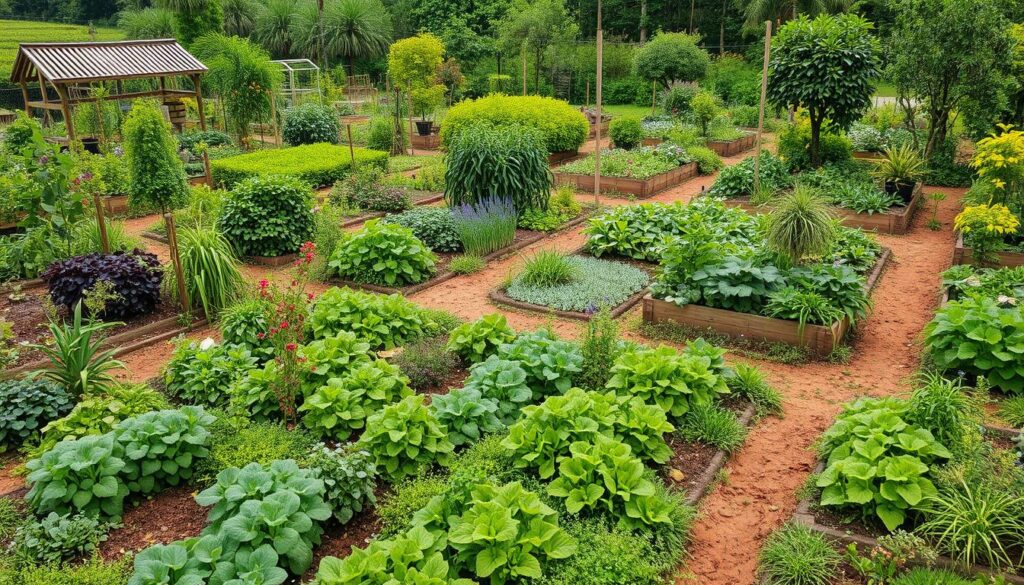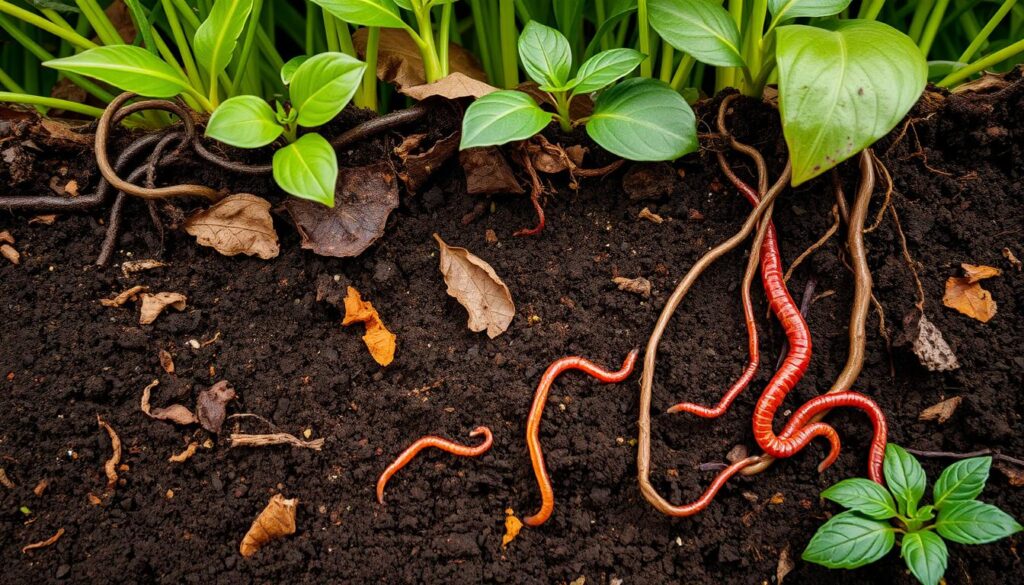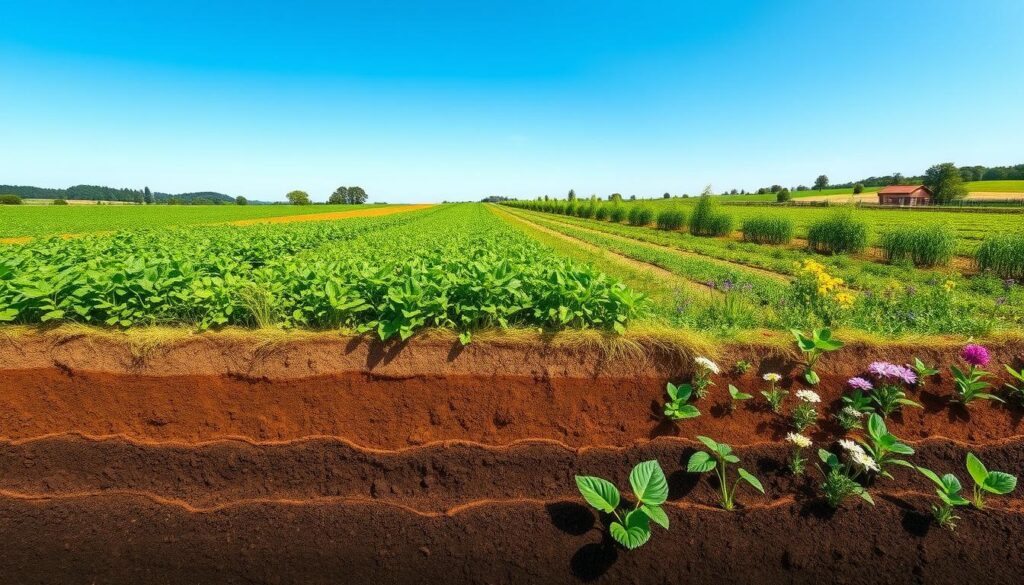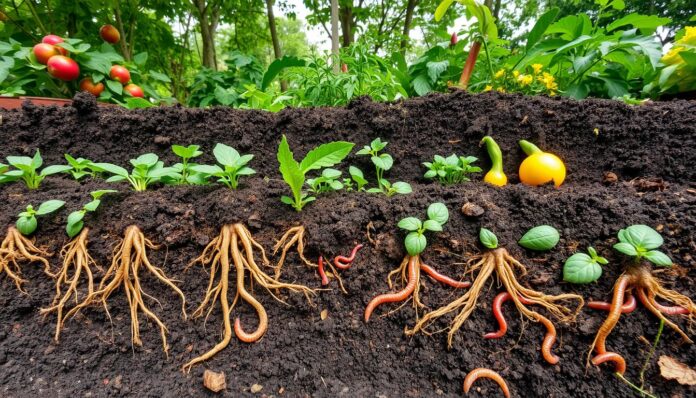What if the secret to a thriving garden is in the soil? Soil degradation is a big problem worldwide, hitting North America’s key farming areas hard. Permaculture offers a way to build soil fertility for the long haul. It’s a holistic approach that helps with sustainable farming and organic practices, making our environment and food systems stronger.
For years, we’ve used synthetic fertilizers to fix soil problems. But these chemicals harm our ecosystems. Permaculture, on the other hand, boosts soil health naturally. It uses compost and organic materials. This way, we can grow more food and reduce harm to our planet.
Key Takeaways
- Soil degradation is a big issue worldwide, affecting land and food.
- Permaculture is a holistic way to improve soil health for the long term.
- Composting and organic matter are key for better soil.
- Using less synthetic fertilizers is vital for a healthy ecosystem.
- Permaculture helps make our food systems and environment healthier.
- Building soil in non-tropical areas is crucial for sustainable farming, and permaculture guides us.
Understanding Soil Fertility in Permaculture
Soil fertility is key in permaculture. It affects how well plants grow and get the nutrients they need. This is linked to natural medicine and holistic health because it impacts the food quality.
Soil fertility is vital for healthy ecosystems. It depends on soil type, organic matter, and microbes. Knowing this helps improve soil health. This supports a sustainable gardening and farming approach, using permaculture principles.
Definition and Importance
Soil fertility means the soil’s ability to give plants the nutrients they need. This includes nitrogen, phosphorus, and potassium. Soil pH, temperature, and moisture also play a role.
Factors Influencing Soil Fertility
Several things can change soil fertility:
- Soil composition: The mix of clay, silt, and sand affects fertility.
- Organic matter: Compost or manure adds nutrients.
- Microbial activity: Bacteria and fungi help break down matter and release nutrients.
Understanding these factors helps improve soil health. This leads to ecosystems that support many plants and animals. It also promotes holistic health and natural medicine through permaculture.
| Factor | Impact on Soil Fertility |
|---|---|
| Soil composition | Affects nutrient availability and water retention |
| Organic matter | Provides essential nutrients and improves soil structure |
| Microbial activity | Breaks down organic matter and makes nutrients available to plants |
Key Principles of Permaculture
Permaculture is a way to grow food that’s good for the planet. It focuses on making ecosystems that are healthy and can take care of themselves. This approach is based on ethics and design principles that help keep the environment safe.
Key principles include observing and interacting with nature, catching and storing energy, and getting a yield. These work together to make a system that’s good for the future. For instance, by watching nature, we can learn how to help it, not harm it.
Ethics and Design Principles
Permaculture’s ethics are about caring for the earth, people, and sharing what we have. These guide how we design and use permaculture systems. By following these, we can make systems that are not just sustainable but also help the planet get better.
Benefits of permaculture include more biodiversity, better soil, and more ecosystem services. It’s a way to grow food that’s good for everyone.
The Role of Observation
Observation is key in permaculture. It helps us see how nature works and how we can help it. By watching and working with nature, we can make systems that are better for the planet.
Permaculture supports sustainable agriculture by creating diverse ecosystems. This helps balance nature and reduces the need for harmful chemicals. By using permaculture, we can help make our communities healthier and more sustainable.

| Principle | Description |
|---|---|
| Observe and interact with nature | Understand the intricate relationships within ecosystems |
| Catch and store energy | Design systems that conserve and store energy |
| Obtain a yield | Design systems that produce a yield while minimizing environmental impact |
Soil Composition for Fertility
Soil composition is key to soil fertility. Knowing about organic matter in soil is crucial. Leaves add minerals and help improve soil.
Mycology is also vital. Fungi work with plants and help with nutrients. Understanding soil and organic matter helps make gardens better. Important things to think about include:
- Soil layers and their functions
- Essential nutrients and their roles in plant growth
- The impact of organic matter on soil health
Composting adds organic matter and nutrients to soil. This makes soil better for plants. By improving soil, we can make gardens more sustainable and productive.
| Soil Component | Importance |
|---|---|
| Organic Matter | Improves soil structure and fertility |
| Mycology | Contributes to nutrient cycling and plant growth |
The Role of Organic Matter
Organic matter is key to keeping soil fertile. Composting turns waste into a nutrient-rich soil amendment. By adding organic matter to their gardens, people can make their soil more sustainable and strong.
Herbal remedies like comfrey and nettles boost soil fertility and plant growth. These plants improve soil health and structure naturally. Mulch and green manures also help by keeping moisture in, fighting weeds, and controlling soil temperature.

- Improved soil structure and fertility
- Increased water infiltration and retention
- Enhanced microbial activity and biodiversity
- Reduced soil erosion and compaction
Using organic matter, composting, and herbal remedies makes soil more sustainable. This method improves soil health, cuts down on waste, and helps plants grow better.
Practicing Crop Rotation
Crop rotation is key in farming to keep soil healthy and support sustainable agriculture. It helps break disease and pest cycles, improves soil, and boosts nutrient levels. This method is vital for biodiversity and a balanced ecosystem.
The benefits of crop rotation include:
- Soil gets richer in nutrients
- Disease and pests are less common
- Soil structure gets better with deep-rooted plants
- Farmers see higher yields and profits
For crop rotation to work well, planning is crucial. You need to think about the climate, soil type, and which crops to use. By doing crop rotation, we help make farming more sustainable and support biodiversity.
Farmers can use different crop rotation plans like simple, three-year, or four-year rotations. These plans help use soil better, cut down weeds, and keep soil healthy.
| Crop Rotation Strategy | Benefits |
|---|---|
| Simple Rotation | Alternating between two crops each year to maintain soil health |
| Three-Year Rotation | Dividing land into three sections, rotating crops annually to optimize soil usage |
| Four-Year Rotation | Including an extra green manure or cover-crop phase to enhance soil health |
Utilizing Cover Crops
Cover crops are key in regenerative practices. They help improve soil health and support organic farming. By using cover crops, gardeners can make their soil more fertile, reduce erosion, and boost biodiversity.
Ecological garden guru John Jeavons suggests using 4 to 6 times the area of a food garden for cover crops. This helps replace what is taken from harvesting.
There are many types of cover crops. These include fall-planted, warm-season, and year-round varieties. Most cover crop blends have both nitrogen-fixing and non-nitrogen-fixing types. Some examples are:
- Fava beans
- Vetch
- Winter wheat
- Annual grasses and legumes
Using cover crops offers many benefits. They can cut soil erosion by 80% and boost soil microbes by 30%. Cover crops also let gardeners plant summer crops earlier, saving 2-3 weeks. 
| Cover Crop Type | Benefits |
|---|---|
| Nitrogen-fixing | Increases soil fertility |
| Non-nitrogen-fixing | Provides biomass and reduces erosion |
By adding cover crops to their gardens, people help create a more sustainable soil ecosystem. This supports organic farming and regenerative practices.
Enhancing Soil Microbial Life
Soil microbial life is key to keeping soil fertile and healthy. Fungi and bacteria are vital for breaking down nutrients and helping plants grow. To boost these microorganisms, people can use compost tea, manure, and other organic materials.
Mulching and cover cropping also help increase microbial activity. This makes the soil more resilient and sustainable. Mycology, the study of fungi, shows fungi can work with plants to improve nutrient uptake and soil structure. By using mycology in soil care, we can improve soil health in a holistic way.
Here are some ways to boost soil microbial life:
- Adding organic matter, like compost or manure, to the soil
- Using cover crops to reduce soil erosion and increase biodiversity
- Implementing no-till practices to reduce soil disturbance and promote health
By taking these steps, we can support soil microbial life. This creates a more sustainable and resilient soil ecosystem. It also helps with holistic health and well-being.
| Soil Amendment | Carbon to Nitrogen Ratio |
|---|---|
| Sawdust | 500:1 |
| Fish | 7:1 |
| Urine | 1:1 |
Managing Soil pH Levels
Soil pH is key to keeping soil fertile and plants growing well. The pH scale goes from 0 to 14, with 7.0 being neutral. Most plants do best in a pH between 6 and 7.5. In very acidic soils (pH below 5.5), plants can’t get enough nutrients like phosphorus and calcium.
Testing Soil pH
It’s important to test soil pH to know if it’s too acidic or alkaline. Home test kits and electronic pH meters can help. Regular tests keep the soil pH just right for organic farming and biodiversity.
Adjusting pH for Optimal Fertility
To change soil pH, you can use limestone or sulfur. How much you need depends on the soil’s pH, your target pH, and how it holds onto changes. For example, to lower pH by one unit, you might need 1 to 2 pounds of sulfur per 100 square feet. Keeping the soil pH right is vital for a healthy mix of microorganisms and plant growth, which is crucial for soil pH management and organic farming.
The table below shows how different soil pH levels affect plant growth:
| pH Level | Effect on Plant Growth |
|---|---|
| Below 5.5 | Nutrients like phosphorus, calcium, and magnesium become less available |
| 6.0-7.5 | Optimal plant growth, with most plants preferring this range |
| Above 7.5 | Nutrients like iron, manganese, and zinc can become deficient |
Effective soil pH management helps create a healthy environment for biodiversity and plant growth. This is essential for organic farming and keeping soil pH levels healthy.
Implementing No-Till Agriculture
No-till agriculture is a key practice for sustainable farming. It keeps the soil intact, protecting organic matter and soil structure. This method reduces soil erosion and boosts soil life.
It also increases soil organic matter. This makes the soil more resilient and sustainable.
The benefits of no-till practices are many. Some key advantages include:
- Reduced soil erosion
- Increased soil organic matter
- Improved soil biota
- Enhanced water and air circulation
Benefits of No-Till Practices
No-till farming lets farmers plant without tilling the soil. This protects organic matter and keeps the soil structure intact. It can cut down labor hours by 50% and fuel costs by 30%.
It also reduces carbon dioxide emissions from soil by up to 80% compared to traditional tillage.
Transitioning to No-Till Methods
Switching to no-till can take time. Farmers can start by using cover crops to hold the soil in place. They can also add green manures to increase organic matter in the soil.
By adopting no-till, farmers can see higher yields and less soil erosion. They also get a more sustainable soil ecosystem.

Utilizing Permaculture Zones
Permaculture zones are key to a sustainable soil ecosystem. They help promote biodiversity and organic farming. By choosing the right plants, like comfrey and clover, we can improve soil health.

Zone Planning for Soil Health
Planning zones involves looking at climate, soil type, and plant choice. For example, water-loving plants go in better soil zones. Drought-tolerant plants fit in poorer soil zones. This balance helps the soil ecosystem thrive.
Strategic Planting for Soil Fertility
Choosing the right plants is crucial in permaculture zones. Legumes, for instance, add nitrogen to the soil. Crop rotation and composting also keep the soil fertile. These methods support a healthy soil ecosystem and sustainable farming.
- Promotes biodiversity and organic farming practices
- Enhances soil health through strategic plant selection
- Supports a more sustainable and resilient soil ecosystem
Using permaculture zones in gardening helps create a sustainable food system. It also boosts biodiversity and organic farming.
Integrating Animals in Permaculture
Animals are key in permaculture, helping with regenerative practices and holistic health. By adding animals to permaculture, we make our ecosystems more sustainable and strong. Livestock like chickens and cows give us manure, which is full of nutrients and great for fertilizing.
Here are some benefits of having animals in permaculture:
- Manure makes the soil healthier, acting as a natural fertilizer
- It brings more biodiversity and balances the ecosystem
- Animals help control pests, reducing the need for harmful chemicals
- They give us food like meat, milk, eggs, and honey
It’s important to manage manure well to use it safely and effectively. Composting is a good way to do this. It kills bad germs and turns manure into a soil amendment full of nutrients. By using animals in permaculture, we support holistic health and make our environment more sustainable.
| Animal | Benefits |
|---|---|
| Chickens | Provide manure, control insect populations, and aid in soil aeration |
| Cows | Provide manure, aid in soil tilling, and promote soil biota |
| Pigs | Aid in soil aeration and tilling, and provide manure |
Water Management Techniques
Effective water management is key for keeping soil fertile and supporting sustainable agriculture. Techniques like mulching and cover cropping help keep soil moist. This makes the soil more resilient and helps gardens grow better. For more tips on saving water, check out permaculture water conservation resources.
Some important strategies for managing water include:
- Contouring techniques to manage water resources effectively across the landscape
- Utilizing swales to capture and retain rainwater, mitigating the impacts of flooding and drought
- Implementing permaculture techniques to promote biodiversity and support a diverse range of crops and habitats
By using these water management techniques, farmers and gardeners can lower soil erosion. They can also improve water infiltration and soil fertility over time. This is vital for a more
| Technique | Benefits |
|---|---|
| Contouring | Reduces soil erosion, promotes water retention |
| Swales | Captures and retains rainwater, mitigates flooding and drought |
| Permaculture | Promotes biodiversity, supports diverse range of crops and habitats |
Permaculture Biofiltration
Permaculture biofiltration is a key practice that supports regenerative practices and holistic health. It uses plants and microorganisms to clean water. This makes soil healthier and gardens more productive.
Understanding Biofiltration
Biofiltration uses nature to clean water. Plants like wetland species soak up pollutants. Microorganisms like bacteria and fungi break down organic matter and harmful substances.
Implementing Biofilters in Soil Systems
To add biofilters to soil, people can try several methods. Here are a few:
- Creating wetlands or ponds to filter water
- Using plants with deep roots to absorb and break down pollutants
- Adding microorganisms to the soil to enhance biofiltration
By using permaculture biofiltration, individuals can improve soil health. This leads to a more sustainable and resilient soil ecosystem.
Employing Earthworks in Permaculture
Earthworks in permaculture are key to sustainable farming and biodiversity. They help make soil more resilient and healthy. This leads to better gardens and a greener environment.
Some of the benefits of earthworks in permaculture include:
- Reduced soil erosion
- Improved soil biota
- Increased soil moisture retention
- Enhanced biodiversity
Techniques like contour farming, terracing, and swales offer these advantages. For instance, contour farming can cut soil erosion by half and boost moisture retention by 40%. Swales can hold about 75% of rainwater, cutting down on irrigation needs.
Using earthworks in permaculture helps build a sustainable food system. It’s good for the planet and supports farming and biodiversity.
| Technique | Benefit |
|---|---|
| Contour farming | Reduces soil erosion by up to 50% |
| Terracing | Increases arable land by up to 80% |
| Swales | Captures and stores approximately 75% of rainwater runoff |
Advancing Soil Fertility Through Innovation
Improving soil fertility is key for better farming and health. New ways to manage soil help make it more sustainable. This leads to healthier environments and better gardens.
Technology is a big help in taking care of the soil. It lets farmers and gardeners check and boost soil health. Tools like precision agriculture and soil sensors are very useful.
Technology’s Role in Soil Management
Some important technologies for soil care are:
- Precision agriculture: Uses GPS and drones to improve crop growth and cut down on waste.
- Soil sensors: These gadgets track soil moisture and temperature to guide better decisions.
- Artificial intelligence: AI analyzes data from sensors and more to understand soil health.
Case Studies and Successful Innovations
Many examples show how to improve soil health. Using cover crops and green manures boosts soil’s organic matter. Regenerative farming and composting also help.
| Innovation | Description | Benefits |
|---|---|---|
| Cover crops | Planting crops between cash crops to enhance soil health | Improved soil organic matter, reduced erosion |
| Green manures | Planting crops to add organic matter to the soil | Improved soil fertility, increased crop yields |
| Regenerative practices | Practices that promote soil biota and reduce waste | Improved soil health, increased crop resilience |
Assessing Long-Term Soil Health
Soil health assessment is key to keeping soil fertile and supporting sustainable farming. By checking the soil’s physical, chemical, and biological aspects, farmers and gardeners can spot what needs work. This helps improve soil health, making gardens healthier and more productive.
Soil testing, observing, and tracking indicators like organic matter, pH, and microbes are important. These signs tell us a lot about soil health. For instance, soil organic matter is vital for soil structure, microbial life, and nutrient flow.
Some key signs of soil health include:
- Soil organic matter content
- pH levels
- Microbial activity
- Nutrient availability
By watching these signs and using practices like cover cropping, composting, and no-till farming, we can make soil more resilient. This not only helps the environment but also boosts biodiversity and soil health over time.
Regular checks on soil health are crucial for keeping soil fertile and supporting sustainable farming. By managing soil holistically, we can build a strong, sustainable soil system. This leads to a healthier environment and more fruitful gardens.
| Soil Indicator | Importance |
|---|---|
| Soil Organic Matter | Supports microbial activity, regulates nutrient cycling |
| pH Levels | Affects nutrient availability, microbial activity |
| Microbial Activity | Regulates nutrient cycling, supports plant growth |
Conclusion: Building Resilient Soil Systems
Cultivating resilient soil systems is key for a sustainable future in permaculture. We’ve talked about important practices like crop rotation, cover cropping, and composting. These help create a strong and healthy soil ecosystem. The health of our land depends on using these practices.
Summarizing Key Practices
We’ve looked at ways to make soil better and more resilient. Techniques like agroforestry, polyculture, and good water management boost soil health and biodiversity. Also, reducing tillage, composting, and using green manures add nutrients and improve soil structure.
Future of Soil Fertility in Permaculture
The need for sustainable food systems is growing. The future of soil fertility in permaculture is bright. More people and communities are learning about regenerative practices through resources and workshops. By using these practices, we help fight climate change and build a fair food system.

